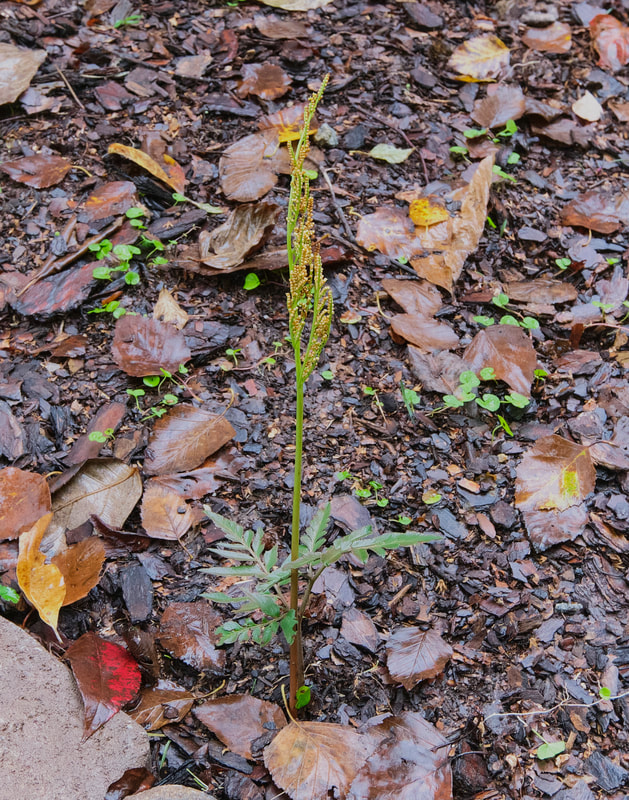Piedmont Mesic Forests
|
Piedmont Mesic Forests grow in cool, shaded sites such as north-facing slopes, within ravines, and on high terraces by streams. These sites are evenly moist but not saturated. Indicator species are American beech, northern red oak, and tulip-tree. Soils here tend to be deeper and richer than those of oak-pine-hickory forests, fostering greater diversity. These forests rarely experience large scale natural disturbance, so trees can grow old and huge. Mesic forests growing over fairly acidic rock are sometimes called "beech forests". Basic mesic forests grow over nutrient-rich amphibolite or marble, and have more diversity and lush growth. Indicator species for the more basic soils include white basswood, white ash, and southern sugar maple. What's special: These forests, especially those over basic rock, host beautiful spring wildflowers before the trees leaf out. The moisture, and nutrients encourage a lush diversity of trees and wildflowers and support a rich animal life, with many amphibians. |
Landscapes
Conservation: Mesic forests experience a small-patch disturbance pattern, in which shade tolerant saplings live for long periods under the canopy, and grow into the canopy (are "released") when a small gap is created by an individual tree or large limb falling to the ground, allowing in more light. Prescribed fires, which can destroy larger patches of trees in a single event, should be kept from reaching the mesic forests. Grades to Oak-Pine-Hickory Forest sites as grow drier.. Grades to Bottomland Forest near floodplains. |
|
Plants
Click on a plant name to see images and more information. Plant lists in order of scientific name. Terms such as "rich", "calcareous" and "mafic" are from The Flora of the Southern and Mid-Atlantic States. Canopy Trees Southern sugar maple Acer floridanum (esp. calcareous and mafic soils ) Red maple Acer rubrum Bitternut hickory Carya cordiformis (especially in rich soils) Red hickory Carya ovalis Shagbark hickory Carya ovata American beech Fagus grandifolia White ash Fraxinus americana Tulip-tree Liriodendron tulipifera Black gum Nyssa sylvatica Cucumber magnolia Magnolia acuminata (esp. calcareous and mafic soils) Fraser magnolia Magnolia fraseri (often fairly acidic soils) Bigleaf magnolia Magnolia macrophylla (esp. calcareous and mafic soils) Umbrella magnolia Magnolia tripetala Red mulberry Morus rubra White oak Quercus alba Northern red oak Quercus rubra Shumard oak Quercus shumardii Sassafras Sassafras albidum (esp. in gaps) White basswood Tilia americana var. heterophylla (rich soils) Subcanopy Trees Downy serviceberry Amelanchier arborea Devil's walking stick Aralia spinosa (often a shrub) Musclewood/American hornbeam Carpinus caroliniana Redbud Cercis canadensis (esp. calcareous or mafic soils) Flowering dogwood Cornus florida Littlehip hawthorn Crataegus spathulata (esp. basic soils) American holly Ilex opaca Shrubs Painted buckeye Aesculus sylvatica (nutrient-rich soils) Pawpaw Asimina triloba (nutrient-rich soils) Beautyberry Callicarpa americana Sweetshrub Calycanthus floridus Strawberry bush Euonymus americana Witch-hazel Hamamelis virginia Flowering hydrangea Hydrangea arborescens Oakleaf hydrangea Hydrangea quercifolia Possumhaw Ilex decidua Mountain laurel Kalmia latifolia (acidic) Doghobble Leucothoe fontanesiana (acidic slopes) Spicebush Lindera benzoin (circumneutral soils, otherwise bottomlands) Big-leaf snowbell Styrax grandifolius Horse sugar Symplocus tinctoria Mapleleaf viburnum Viburnum acerifolium Blackhaw/Nannyberry Viburnum prunifolium Vines Crossvine Bignonia capreolata Trumpet vine Campsis radicans Coralbeads Cocculus carolinus (especially where calcareous) Virgin's bower Clematis virginiana Climbing hydrangea Decumaria barbara Whorled wild yam Dioscorea villosa Virginia creeper Parthenocissus quinquefolia Bay star-vine Schisandra glabra (rich slopes near bottomlands) Greenbrier (whiteleaf/sawbrier) Smilax glauca Yellow passionflower Passiflora lutea Poison ivy Toxicodendron radicans Muscadine Vitis rotundifolia Ground Layer Wildflowers Dolls'-eyes Actaea pachypoda (rich forests) Black cohosh Actaea racemosa (rich to very fertile forests) White snakeroot Ageratina altissima Fly poison Amianthium muscitoxicum Blue-stars Amsonia tabernaemontana Sharp-lobed hepatica Anemone acutiloba (esp. calcareous and mafic) Round-lobed hepatica Anemone americana Jack-in-the-pulpit Arisaema triphyllum Wild ginger Asarum canadense (rich, circumneutral soils) Cutleaf toothwort Cardamine concatenata (rich forests) Broadleaf toothwort Cardamine diphylla (rich forests) Blue cohosh Caulophyllum thalictroides (rich forests) Devil's-bit Chamaelirium luteum Horsebalm (southern/anise) Collinsonia anisata (rich forests) Horsebalm (northern) Collinsonia canadensis (rich forests, esp. mafic or calcareous) Yellow lady's-slipper Cypripedium parviflorum Beech drops Epifagus virginiana Harbinger-of-spring Erigenia bulbosa Trout lily Erythronium umbilicatum Wild geranium Geranium maculatum Avens Geum canadense Downy rattlesnake-orchid Goodyera pubescens Heartleaf ginger/little brown jugs Hexastylis arifolia Goldenseal Hydrastis canadensis (mafic and calcareous) Crested iris Iris cristata (rich forests) Fringed loosestrife Lysimachia ciliata Partridgeberry Mitchella repens Indian pipes Monotropa uniflora Hairy sweet cicely Osmorhiza claytonii (fertile forests) Smooth sweet cicely Osmorhiza longistylis (fertile forests) Violet wood-sorrel Oxalis violaceae Ginseng Panax quinquefolius (nutrient rich forests) May-apple Podophyllum peltatum (rich forests) Shooting star (eastern) Primula meadia (primarily calcareous or mafic soils) Carolina petunia Ruellia caroliniensis Bloodroot Sanguinaria canadensis (nutrient-rich forests) Starry campion Silene stellata Blue-eyed grass Sisyrinchium angustifolius Axillary goldenrod Solidago caesia Indian pink Spigelia marilandica (usually circumneutral) Giant chickweed Stellaria pubera Rue anemone Thalictrum thalictroides Foamflower Tiarella wherryi Tassel-rue Trautvetteria caroliniensis Catesby's trillium Trillium catesbaei Sweet Betsy/Toadshade trillium Trillium cuneatum (rich forests, usually mafic or calcareous rocks) Nodding trillium Trillium rugelii (rich soils, usually mafic or calcareous) Perfoliate bellwort Uvularia perfoliata Halberd-leaf violet Viola hastata (often acidic coves) Ferns Northern maidenhair fern Adiantum pedatum (esp. mafic or calcareous soils) Ebony spleenwort Asplenium platyneuron Southern lady fern Athyrium asplenioides Rattlesnake fern Botrypus virginianus (especially on nutrient-rich slopes; fruit spring/summer) Silvery glade fern Homalosorus pycnocarpon (very nutrient-rich forests over mafic or calcareous rock) New York fern Parathelypteris novaboracensis Broad beech fern Phegopteris hexagonoptera Christmas fern Polystichum acrosticoides Southern grape fern Sceptridium biternatum (Fruit summer/fall) Grasses, Sedges and Rushes Upland oats Chasmanthium sessiliflorum Nimblewill/Nimbleweed Muhlenbergia schreberi |
Some Representative Trees in order of scientific name. Representative shrubs in order of scientific name
Representative vines in order of scientific name
Representative wildflowers in order of scientific name.
Representative Ferns
Representative Birds |
















































































